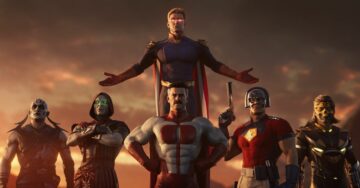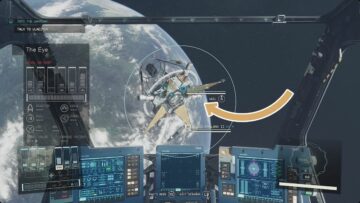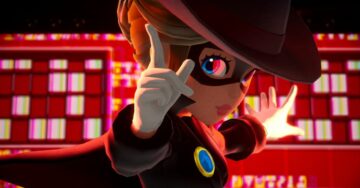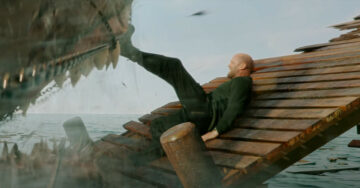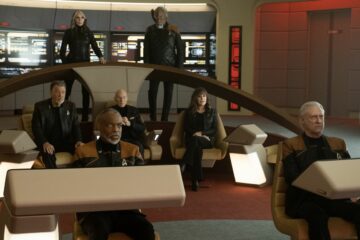Godzilla Minus One is the throwback movie that longtime Godzilla fans have been waiting for. This is an age of abundance for Godzilla media: Over the past seven years, as part of a partnership between Toho and Hollywood studios, the giant lizard received three animated films on Netflix, two U.S. movies, and an Apple TV series that premieres Nov. 17. Godzilla fans like me haven’t been left wanting. And yet something crucial has been missing from most of this media, something fundamental to the earliest films in the Godzilla franchise: terror.
We nearly had a decade of terrifying Godzilla. In 2016, Hideaki Anno and Shinji Higuchi released the horrifying Shin Godzilla, widely regarded as one of the best entries in the franchise. It promised a return to the petrifying, humanity-destroying Godzilla of the past. But Shin Godzilla marked a lengthy hiatus in the production of Japanese live-action Godzilla films, and signaled the beginning of a colossally successful American era for the big lizard. The American Godzilla media of the past seven years, including Godzilla: King of the Monsters, Godzilla vs. Kong, and those Netflix anime movies, ranges from serviceable to pretty damn good, though its creators borrowed far more from the Marvel Cinematic Universe than from classic kaiju matinees.
After years of letting Hollywood take its contractually mandated turn, Toho returns with a literal throwback movie that lands Godzilla nearly a century in the past. He doesn’t have any adorable friends in this new Japanese-produced live-action period piece. You won’t see him save Tokyo from a kaiju that represents oceanic pollution, or a reptilian mech that embodies capitalism gone awry. Nor will you spot King Kong or hear mention of the Monsterverse.
Instead, Godzilla Minus One sticks to the original recipe. The movie that kicked it all off, 1954’s Godzilla, mixes horror, classic melodrama, and a feverish anti-war message to mine the anxieties of ’50s Japan. Minus One goes even further into the past, with a story set in the immediate aftermath of World War II. Writer-director Takashi Yamazaki (who took another beloved franchise back to basics with Lupin III: The First) imagines how a Japan with no military, no economy, and no international support would respond to Godzilla’s first attack.
So is this a reboot? A remake? A reimagining? A bit of all of the above.
[embedded content]
Our reluctant hero is Koichi Shikishima (Ryunosuke Kamiki), a kamikaze pilot who, in the waning hours of the war, faked a plane malfunction to escape death. In a Godzilla film, the giant monsters typically carry the central political metaphor, but in Minus One, Koichi shoulders that burden on his tiny human frame. As a kamikaze pilot who survived the war, he returns to his neighborhood to find that little remains beyond rubble and a few surviving neighbors.
This is ground-level Godzilla storytelling: We see the events through the eyes of Koichi, his neighbors, and his co-workers, rather than through knowledgeable government leaders, superhuman soldiers, or Godzilla himself. As with any great kaiju film, we spend much of the film’s first half learning to care about these lovable folks just before their world gets obliterated by hundreds of tons of giant lizard.
Koichi is an unusually grim lead, even by the standards of the more somber early Godzilla films. He despises himself for his decision to bail on his kamikaze mission, and his neighbors, who’ve lost their homes and families, aren’t especially thrilled to see him either. Nonetheless, together they rebuild from bombed-out blocks to bivouacked shacks, and eventually to modest homes that cluster among the suburban Tokyo sprawl. Considering this a Godzilla movie, it’s like watching people rebuilding their lives with a giant box of dominoes.
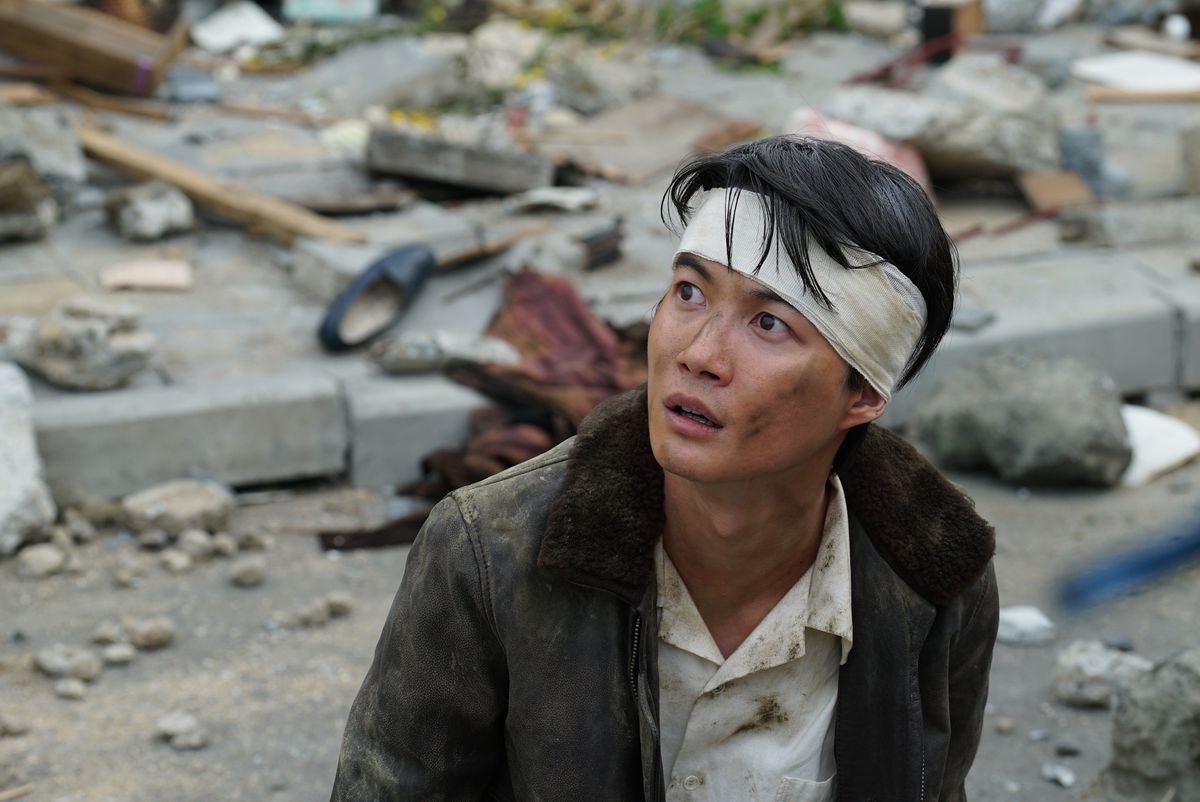
Minus One isn’t a period piece in aesthetic alone: The story itself feels like something preserved from the 1950s. Yamazaki steeps it in the melodrama of a classic historical epic. His characters are capital-R Romantic, constantly making bold proclamations and grand sacrifices, discussing heavy topics where modern characters would quip about shawarma.
Koichi and his companions debate the power of nonviolence, the value of self-preservation, and the unjust expectations governments put upon their populations in times of war. The latter point makes Godzilla Minus One a surprisingly potent pairing with Hayao Miyazaki’s animated semi-biopic The Wind Rises, and a timely response to Japan’s current military buildup.
Of course, it’s precisely when Koichi and company begin to open their hearts and get their feet on the ground that Godzilla arrives. (Technically, he appears earlier in the film, but I’ll spare you the spoilers.) When Godzilla makes his first legitimate impression, he strikes like a 2023 version of the original Godzilla: the living manifestation of nuclear terror. His initial physical destruction is dwarfed by his heat ray, which, as shown in the trailer, leaves behind little more than a crater and a mushroom cloud.
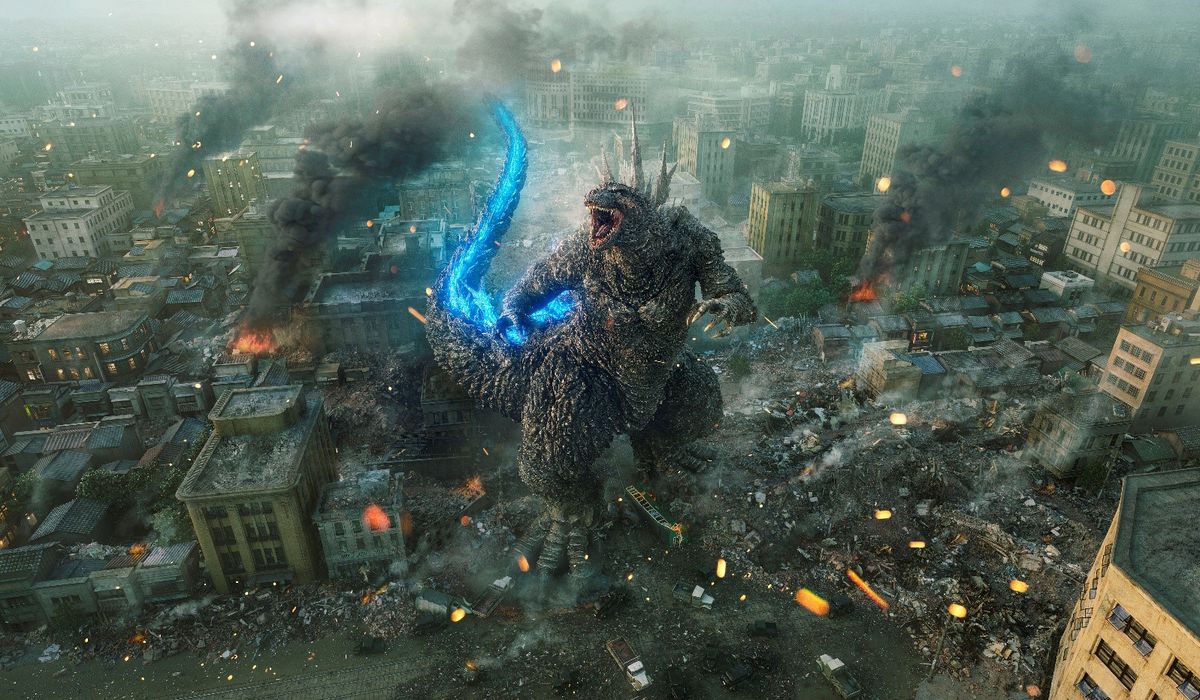
This is the moment in modern Godzilla movies where the heroes send in mechs, a rival kaiju, or some cutting-edge military aircraft. But Minus One, to its credit, sticks to the original formula, using historical reality to wave away any easy solutions. Most of Japan’s military has been decommissioned following its surrender to the U.S., its remaining warships sent away for disassembly. The U.S. government won’t help, either; its government is afraid to move weaponry into the region, which might provoke an anxious Soviet Union. So there’s only one group left to stop Godzilla: the civilian population. It’s a legitimately terrifying prospect — a group of average people versus a kaiju.
For those of us under the age of 70, conceptualizing Godzilla as a genuinely frightening horror monster can be a challenge. Hell, he appears in an upcoming children’s book that espouses the power of love. But in 1954, Godzilla terrified audiences across the globe, as a metaphor for nuclear weapons’ imprecise, passionless ability to level whole cities.
In its back half, Minus One recreates that style of terror with human stakes and an intensely political message. Yamazaki brings together the threads he carefully put in place: Koichi’s mental health, the barely rebuilt Japan, the absent government, the abandoned military, and, in true classic melodrama fashion, a love story. Then he pits them against an indifferent, catastrophic force.
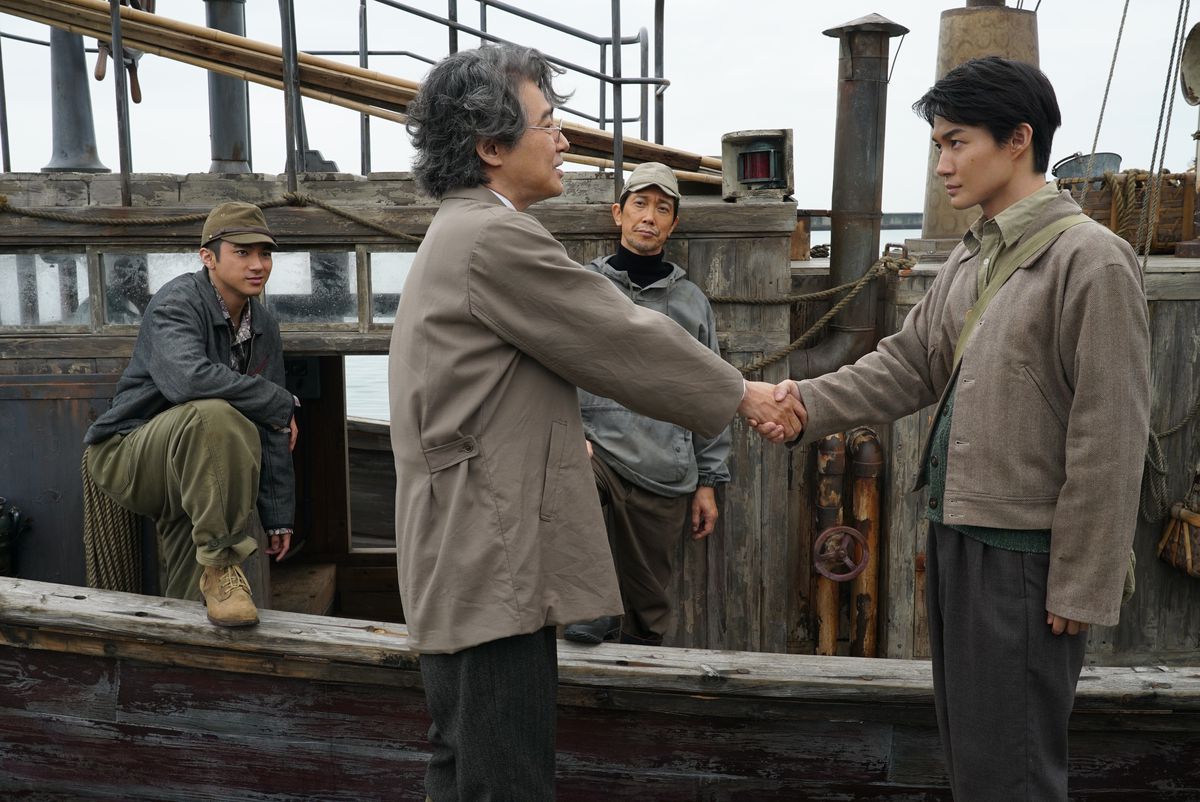
Is Godzilla the threat of nuclear weaponry? The temptation to respond to violence with greater violence? An indifferent American military in a period of national rebuild? The fact that Godzilla Minus One prompts these questions underscores what modern Godzilla media has been missing.
Don’t get me wrong; I’ve enjoyed the near-decade of Godzilla entertainment in America. But as someone who has Shin Godzilla at the top of his Godzilla tier list, who introduced his child to Mothra at far too young an age, and has a Hedorah anatomy poster sitting behind him at this very moment, this is the Godzilla I’ve been waiting for.
Godzilla films provide filmmakers a precious opportunity to tell political stories not just about individuals, but about communities, or even entire nations. And because Godzilla movies will always feature a kaiju destroying famous cities and landmarks like a toddler let loose in a Lego museum, people will show up. It’s a fantastic entertainment vessel for big ideas. For years now, Godzilla has been giving us plenty of sugar. But considering the state of the world, I’m glad he’s once again showing up with a bit of medicine, too.
Godzilla Minus One opens in Japan on Nov. 3 and will arrive in U.S. theaters on Dec. 1, with early-access fan event screenings on Nov. 29.
- SEO Powered Content & PR Distribution. Get Amplified Today.
- PlatoData.Network Vertical Generative Ai. Empower Yourself. Access Here.
- PlatoAiStream. Web3 Intelligence. Knowledge Amplified. Access Here.
- PlatoESG. Carbon, CleanTech, Energy, Environment, Solar, Waste Management. Access Here.
- PlatoHealth. Biotech and Clinical Trials Intelligence. Access Here.
- Source: https://www.polygon.com/reviews/23940888/godzilla-minus-one-review
- :has
- :is
- :not
- :where
- $UP
- 1
- 2016
- 2023
- 29
- 70
- a
- ability
- About
- above
- absent
- abundance
- across
- afraid
- aftermath
- again
- against
- age
- aircraft
- All
- alone
- always
- america
- American
- among
- an
- anatomy
- and
- Anime
- Another
- any
- appears
- Apple
- apple tv
- ARE
- Arrives
- AS
- At
- attack
- audiences
- average
- away
- back
- bail
- Basics
- BE
- because
- been
- before
- begin
- Beginning
- behind
- beloved
- BEST
- between
- Beyond
- Big
- Bit
- Blocks
- bold
- book
- borrowed
- Box
- Brings
- burden
- but
- by
- CAN
- care
- carefully
- carry
- catastrophic
- Century
- challenge
- characters
- child
- cinematic
- Cities
- City
- classic
- Cloud
- Cluster
- CO
- Communities
- companions
- company
- considering
- constantly
- content
- course
- creators
- credit
- crucial
- Current
- cutting-edge
- Death
- debate
- decade
- decision
- discussing
- distance
- Doesn’t
- Earlier
- earliest
- Early
- easy
- economy
- either
- embedded
- embodies
- enjoyed
- Entertainment
- Entire
- EPIC
- Era
- escape
- especially
- Ether (ETH)
- Even
- Event
- events
- eventually
- expectations
- Eyes
- fact
- families
- famous
- fan
- fans
- fantastic
- far
- Fashion
- Feature
- Feet
- fellow
- few
- Film
- filmmakers
- films
- Find
- First
- following
- For
- Force
- formula
- FRAME
- Franchise
- from
- fundamental
- further
- get
- giant
- Giving
- globe
- Goes
- gone
- good
- Government
- Government Leaders
- Governments
- grand
- great
- greater
- grim
- Ground
- Group
- had
- Half
- Hands
- Have
- he
- Health
- hear
- heavy
- help
- Hero
- Heroes
- him
- himself
- his
- historical
- Hollywood
- Homes
- horrifying
- horror
- HOURS
- How
- HTML
- HTTPS
- huge
- human
- Hundreds
- I’LL
- ideas
- ii
- iii
- immediate
- in
- Including
- individuals
- initial
- International
- into
- introduced
- IT
- ITS
- itself
- Japan
- Japan’s
- Japanese
- jpg
- just
- King
- lands
- lead
- leaders
- learning
- left
- legitimate
- let
- letting
- Level
- like
- List
- little
- Lives
- living
- LOOKS
- lost
- love
- MAKES
- Making
- marked
- marvel
- me
- Media
- medicine
- mental
- Mental health
- mention
- message
- might
- Military
- mine
- missing
- Mission
- Modern
- modest
- moment
- more
- most
- move
- movie
- Movies
- much
- Museum
- National
- Nations
- nearly
- neighbors
- Netflix
- New
- no
- nor
- nov
- now
- nuclear
- of
- off
- on
- once
- ONE
- only
- open
- opens
- Opportunity
- or
- original
- over
- pairing
- part
- Partnership
- past
- People
- period
- physical
- piece
- pilot
- Place
- plane
- plato
- Plato Data Intelligence
- PlatoData
- Plenty
- Point
- political
- Polygon
- population
- populations
- poster
- potent
- power
- Precious
- precisely
- preserved
- pretty
- Production
- promised
- prospect
- provide
- put
- Questions
- rather
- RAY
- Reality
- rebuilding
- received
- recipe
- regarded
- region
- reimagining
- remaining
- remains
- represents
- Respond
- response
- return
- returns
- Rival
- s
- Save
- see
- send
- sent
- Series
- set
- seven
- shoulders
- show
- showing
- shown
- Sitting
- So
- Solutions
- some
- Someone
- something
- soviet
- spend
- Sponsored
- stakes
- standards
- State
- Stop
- Stories
- Story
- storytelling
- Strikes
- studios
- style
- successful
- sugar
- superhuman
- support
- Survived
- Take
- technically
- tell
- terrifying
- than
- that
- The
- The State
- the world
- their
- Them
- then
- These
- they
- this
- those
- though?
- threat
- three
- thrilled
- Through
- tier
- timely
- times
- to
- together
- tokyo
- tons
- too
- took
- top
- Topics
- true
- TURN
- tv
- TV Series
- two
- typically
- u.s.
- U.S. government
- under
- underscores
- union
- Universe
- upcoming
- upon
- us
- using
- value
- version
- Versus
- very
- Vessel
- violence
- vs
- Waiting
- wanting
- war
- watching
- Wave
- we
- webp
- What
- when
- which
- WHO
- whole
- widely
- Wikipedia
- will
- wind
- with
- world
- would
- Wrong
- years
- yet
- you
- young
- youtube
- zephyrnet

